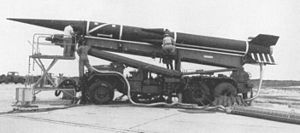- Alpha Draco
-
For the star Alpha Draconis, see Thuban.
Alpha Draco 
The Alpha Draco test vehicleType Experimental rocket Place of origin  United States
United StatesService history In service 1959 Used by United States Air Force Production history Designed 1957-1958 Manufacturer McDonnell Number built 3 Specifications Length 46.1 feet (14.05 m) Diameter 31 inches (790 mm) Engine First stage, Thiokol TX-20
50,000 lbf (222 kN)
Second stage, Thiokol TX-30
12,300 lbf (54.8 kN)Wingspan 7.1 feet (2.16 m) Propellant Solid fuel Operational
range240 miles (390 km) Flight ceiling 100,000 feet (30,000 m) Speed Mach 5+ The Alpha Draco missile, also known as Weapons System 199D (WS-199D), was an experimental missile developed by McDonnell Aircraft in the late 1950s to investigate boost-glide reentry. Three test flights were conducted in 1959, of which two were successful.
Contents
Design and development
As part of the WS-199 project to develop new strategic weapons for the United States Air Force's Strategic Air Command, McDonnell Aircraft developed the Alpha Draco missile between 1957 and 1959. The purpose of the rocket was to establish whether a strategic missile using the "boost-glide" principle of propulsion could be practically used.[1]
The Alpha Draco missile was a two-stage vehicle, the first stage comprising a Thiokol TX-20 solid-fuel rocket of the type used in the MGM-29 Sergeant theatre ballistic missile, and the second stage using a Thiokol TX-30 solid-fuel rocket. The payload vehicle was aerodynamically shaped, using the lifting body principle to provide aerodynamic lift;[2] following burnout of the first stage, the vehicle would coast for a short time before ignition of the second stage,[1] burnout of the second stage was followed by the vehicle entering the glide phase of flight, which would be terminated by a dive upon the target.[3]
Operational history
Three test launches of the Alpha Draco vehicle were conducted during 1959,[2] the missile being launched from a land-based gantry. The initial flight, on February 16, was successful; the second flight, one month later, also fulfilled its test goals. The final launch of the Alpha Draco on April 30, however, suffered a flight-control failure and was destroyed by range safety command.[3] With the expenditure of the third and final vehicle, the program came to a halt,[1] the project's cost having come to a total of approximately $5 million USD, the knowledge gained in the project proving invaluable to the development of re-entry vehicles for future intercontinental ballistic missiles.[3]
See also
- Related development
- Bold Orion
- High Virgo
References
- Notes
- Bibliography
- Parsch, Andreas (20058). "WS-199". Directory of U.S. Military Rockets and Missiles. designation-systems.net. http://www.designation-systems.net/dusrm/app4/ws-199.html. Retrieved 2010-12-29.
- Yengst, William (2010). Lightning Bolts: First Manuevering Reentry Vehicles. Mustang, OK: Tate Publishing & Enterprises. ISBN 978-1-61566-547-1.
- Yenne, Bill (2005). Secret Gadgets and Strange Gizmos: High-Tech (and Low-Tech) Innovations of the U.S. Military. St. Paul, MN: Zenith Press. ISBN 978-0-7603-2115-7.
External links
 Media related to Alpha Draco at Wikimedia Commons1955-1962 United States Air Force rocket and missile designations
Media related to Alpha Draco at Wikimedia Commons1955-1962 United States Air Force rocket and missile designationsAir-to-air missiles Other missiles - See also:
- Alpha Draco
- Bold Orion
- High Virgo
- Pye Wacket
- Sky Scorcher
- United States tri-service missile and drone designations post-1962
Types of missile By platform - Air-to-air missile (AAM)
- Air-to-surface missile (ASM)
- Surface-to-air missile (SAM)
- Surface-to-surface missile (SSM)
- Ballistic missile
- Intercontinental ballistic missile (ICBM)
- Submarine-launched ballistic missile (SLBM)
- Anti-ballistic missile (ABM)
- Intermediate-range ballistic missile (IRBM)
- Cruise missile
- Anti-ship missile (AShM)
- Anti-submarine missile
- Anti-tank missile (ATGM)
- Anti-satellite weapon (ASAT)
- Air-launched ballistic missile
- Anti-ship ballistic missile (ASBM)
By guidance Lists - List of missiles
- List of missiles by country
- List of military rockets
Categories:- Cold War missiles of the United States
- Experimental missiles
- Short-range ballistic missiles
Wikimedia Foundation. 2010.
